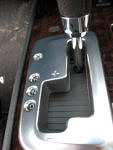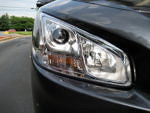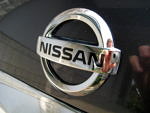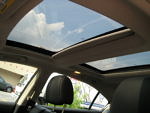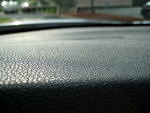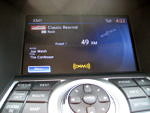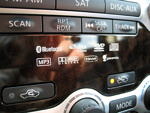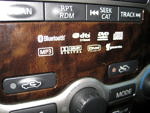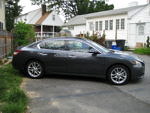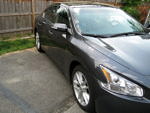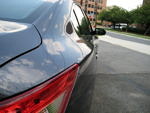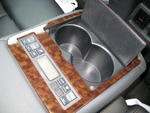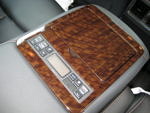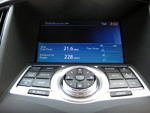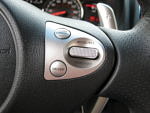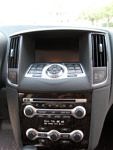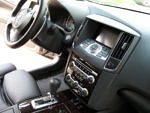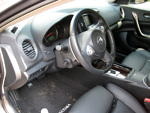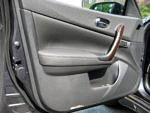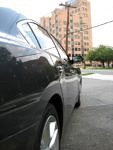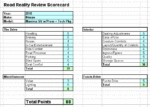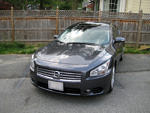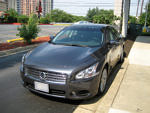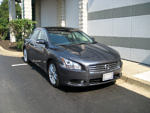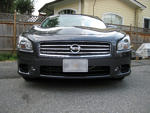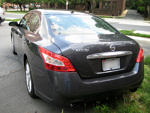 Over the past few generations of Nissan’s sedans, the Altima and Maxima, a lot of people have started to wonder why both continue to be built. Whereas the Maxima used to be a bigger sedan than the Altima, it had actually become smaller. Then a redesign of the Maxima in 2004 made it bigger again, but it lost some of the sporty demeanor it has been known for. In 2009, Nissan redesigned the Maxima again, this time trying to get back to its 4-Door Sports Car (4DSC) roots. Smaller than its predecessor, but wearing much more sculpted sheetmetal, how does the new Maxima drive? Read on for my impression.
Over the past few generations of Nissan’s sedans, the Altima and Maxima, a lot of people have started to wonder why both continue to be built. Whereas the Maxima used to be a bigger sedan than the Altima, it had actually become smaller. Then a redesign of the Maxima in 2004 made it bigger again, but it lost some of the sporty demeanor it has been known for. In 2009, Nissan redesigned the Maxima again, this time trying to get back to its 4-Door Sports Car (4DSC) roots. Smaller than its predecessor, but wearing much more sculpted sheetmetal, how does the new Maxima drive? Read on for my impression.
 For many years, the Nissan Maxima has been marketed as the 4-Door Sports Car (4DSC). It’s been offered with a manual transmission, plenty of power and great handling. It came with everything you’d expect from a sports car, but with two extra doors and a proper trunk. In 2004, Maxima fans balked at how big their sporting sedan had gotten, even though it was built with Nissan’s corporate V6, the “VQ” and a manual transmission. They got even more upset in 2007, when the manual transmission was ditched in favor a Continuously Variable Transmission, or CVT.
For many years, the Nissan Maxima has been marketed as the 4-Door Sports Car (4DSC). It’s been offered with a manual transmission, plenty of power and great handling. It came with everything you’d expect from a sports car, but with two extra doors and a proper trunk. In 2004, Maxima fans balked at how big their sporting sedan had gotten, even though it was built with Nissan’s corporate V6, the “VQ” and a manual transmission. They got even more upset in 2007, when the manual transmission was ditched in favor a Continuously Variable Transmission, or CVT.
 That last statement may have you scratching your head and asking what a CVT is, so I’ll give a quick explanation. A Continuously Variable Transmission replaces the standard gears in an automatic or manual transmission with a pair of pulleys and a belt that rides between them. Split vertically, these pulleys feature a deep “V” shape to them, which the belt rides in. By changing the depth of the “V”, the CVT gets its gear ratios. (for a great article on CVTs, head over to HowStuffWorks.com). What this leads to is faster and very smooth acceleration, gentler overall operation and increased fuel efficiency.
That last statement may have you scratching your head and asking what a CVT is, so I’ll give a quick explanation. A Continuously Variable Transmission replaces the standard gears in an automatic or manual transmission with a pair of pulleys and a belt that rides between them. Split vertically, these pulleys feature a deep “V” shape to them, which the belt rides in. By changing the depth of the “V”, the CVT gets its gear ratios. (for a great article on CVTs, head over to HowStuffWorks.com). What this leads to is faster and very smooth acceleration, gentler overall operation and increased fuel efficiency.
 Nissan, finally returning to the 4DSC roots of the Maxima, redesigned the car for 2009. With the new model comes a slight increase in weight and slightly smaller exterior dimensions. It also comes with the addition of more power, better handling and a driver-oriented “cockpit”-style interior. The weight increase can be attributed to the new European pedestrian safety laws, which have affected nearly every automaker, as they change the front ends of their vehicles to be safer in pedestrian collisions. The extra pounds are also explained by the added standard and optional features found in the Maxima. While it’s a rare sight to see a new car be smaller than its predecessor, the Maxima succeeds in that regard, compared to the 2004-2008 model it replaces.
Nissan, finally returning to the 4DSC roots of the Maxima, redesigned the car for 2009. With the new model comes a slight increase in weight and slightly smaller exterior dimensions. It also comes with the addition of more power, better handling and a driver-oriented “cockpit”-style interior. The weight increase can be attributed to the new European pedestrian safety laws, which have affected nearly every automaker, as they change the front ends of their vehicles to be safer in pedestrian collisions. The extra pounds are also explained by the added standard and optional features found in the Maxima. While it’s a rare sight to see a new car be smaller than its predecessor, the Maxima succeeds in that regard, compared to the 2004-2008 model it replaces.
 When viewing the Maxima, it’s best to take in all the surfaces. The front end evokes mental images of Aston Martin’s current offerings, while the rear fenders seem to be taken from Ferrari. The entire body has an hourglass figure to it, letting the front and rear fenders flare out from a somewhat thinner midsection – the passenger cabin. Besides the two side rails, which run from the base of the windshield to the trunk, there is no metal on the Maxima’s roof. It’s merely five pieces of glass, all of which come together to make up the dual panel moonroof/sunroof that has become popular for higher-end vehicles, including crossovers and some SUVs. High-intensity (HID) headlights and LED taillights round out the Maxima’s exterior, the former becoming main stream, the latter just starting to appear as factory equipment on some vehicles. The LED, or Light-Emitting Diode, has been around for many years, but has recently seen use in new cars and trucks, as a longer-lasting taillamp, and in some cases, headlights as well. LEDs typically outlast traditional bulbs by a factor of 10, which means that they don’t need replacing nearly as often.
When viewing the Maxima, it’s best to take in all the surfaces. The front end evokes mental images of Aston Martin’s current offerings, while the rear fenders seem to be taken from Ferrari. The entire body has an hourglass figure to it, letting the front and rear fenders flare out from a somewhat thinner midsection – the passenger cabin. Besides the two side rails, which run from the base of the windshield to the trunk, there is no metal on the Maxima’s roof. It’s merely five pieces of glass, all of which come together to make up the dual panel moonroof/sunroof that has become popular for higher-end vehicles, including crossovers and some SUVs. High-intensity (HID) headlights and LED taillights round out the Maxima’s exterior, the former becoming main stream, the latter just starting to appear as factory equipment on some vehicles. The LED, or Light-Emitting Diode, has been around for many years, but has recently seen use in new cars and trucks, as a longer-lasting taillamp, and in some cases, headlights as well. LEDs typically outlast traditional bulbs by a factor of 10, which means that they don’t need replacing nearly as often.
 Listed as an entry-level luxury sedan, the Maxima has features you’d expect of it, such as keyless entry and push-button start, and with that comes a button on the driver and passenger door handles to unlock them. Sliding into the driver’s seat, you’ll notice a fair amount of depth to the seat – the side bolsters work hard to keep you firmly planted in the bucket seat. Looking around, all the seats are buckets, even though the rear seat is supposed to seat 3. I’d say a small child could sit there, but no adult will be happy riding in the middle seat for very long. Rear passengers have a decent, if not commodious amount of headroom, which is somewhat limited because of the coupe-like design of the roof. Leg and hip room are about average for a mid-sized car, but larger passengers definitely won’t be as comfortable, given the sporty seats. On long drives, a driver who is wide in the shoulders will notice that the side bolster on the right wants to cut into his or her shoulder, and because of their firmness, the seats can become tiresome, leading to fidgety driver and passenger. The front seats are both power operated, with plenty of adjustability, including a manual thigh extension for the driver.
Listed as an entry-level luxury sedan, the Maxima has features you’d expect of it, such as keyless entry and push-button start, and with that comes a button on the driver and passenger door handles to unlock them. Sliding into the driver’s seat, you’ll notice a fair amount of depth to the seat – the side bolsters work hard to keep you firmly planted in the bucket seat. Looking around, all the seats are buckets, even though the rear seat is supposed to seat 3. I’d say a small child could sit there, but no adult will be happy riding in the middle seat for very long. Rear passengers have a decent, if not commodious amount of headroom, which is somewhat limited because of the coupe-like design of the roof. Leg and hip room are about average for a mid-sized car, but larger passengers definitely won’t be as comfortable, given the sporty seats. On long drives, a driver who is wide in the shoulders will notice that the side bolster on the right wants to cut into his or her shoulder, and because of their firmness, the seats can become tiresome, leading to fidgety driver and passenger. The front seats are both power operated, with plenty of adjustability, including a manual thigh extension for the driver.
 Back up front, the center stack looks like it was ripped directly from the Infiniti G37, and it was. The recessed and hooded navigation screen sits above the controls for the audio and navigation, and further down, the climate controls. There’s a nice flow to this design, one that Honda could learn a lot from. My only gripe with this area of the dash is that the volume knob and driver’s temperature control knob are lined up vertically and are the same size, shape and feel. They are a few inches apart, and after a few drives, I no longer reach for the wrong one. The steering wheel is comfortable, wrapped in leather, and the up and down-shift paddles mounted on the steering column are easy to use as well. Given this car’s sporty premise, it’s no surprise to see the paddles, but the gear shift lever also features a manual mode. Regardless of how you operate it, the CVT only approximates the 6 gears it lets you control. Drivers have actually found that driving in standard “D” mode is the fastest, but using the gear shift lever or paddles to control the transmission has a better seat-of-the-pants feel.
Back up front, the center stack looks like it was ripped directly from the Infiniti G37, and it was. The recessed and hooded navigation screen sits above the controls for the audio and navigation, and further down, the climate controls. There’s a nice flow to this design, one that Honda could learn a lot from. My only gripe with this area of the dash is that the volume knob and driver’s temperature control knob are lined up vertically and are the same size, shape and feel. They are a few inches apart, and after a few drives, I no longer reach for the wrong one. The steering wheel is comfortable, wrapped in leather, and the up and down-shift paddles mounted on the steering column are easy to use as well. Given this car’s sporty premise, it’s no surprise to see the paddles, but the gear shift lever also features a manual mode. Regardless of how you operate it, the CVT only approximates the 6 gears it lets you control. Drivers have actually found that driving in standard “D” mode is the fastest, but using the gear shift lever or paddles to control the transmission has a better seat-of-the-pants feel.
 Overall, the fit and finish and material quality in the cabin of the Maxima is very good. Hard plastics are used sparingly, and the soft touch materials all have a pleasant texture to them. The designers also used wood veneers in certain areas, complementing the black leather very well, although it shows all dust and dirt, and seems to be a magnet for it! The steering wheel-mounted controls, which include the voice-activated navigation and audio, are easy to use and are different in shape and texture, making it easy to use them at night and without looking. The arm rest on the center console is a bit too firm, leading to fatigue during a long drive. If Nissan had added another quarter-inch or so of padding underneath its leather, the arm rest would be quite comfortable.
Overall, the fit and finish and material quality in the cabin of the Maxima is very good. Hard plastics are used sparingly, and the soft touch materials all have a pleasant texture to them. The designers also used wood veneers in certain areas, complementing the black leather very well, although it shows all dust and dirt, and seems to be a magnet for it! The steering wheel-mounted controls, which include the voice-activated navigation and audio, are easy to use and are different in shape and texture, making it easy to use them at night and without looking. The arm rest on the center console is a bit too firm, leading to fatigue during a long drive. If Nissan had added another quarter-inch or so of padding underneath its leather, the arm rest would be quite comfortable.
 It’s 2010, and while some manufacturers (I’m looking at you, Mazda) refuse to wake up and add decent infotainment packages to their offerings, Nissan has embraced the MP3 player, giving owners the flexibility to plug darn near any USB drive or music device into their Maxima. They went so far as to include the USB port, an auxiliary input (1/4″) jack, and the red/yellow/white ports for RCA connectors. When in Park with the parking brake engaged, you can watch DVDs on the 7″ touchscreen used for the navigation, or video off of the RCA connectors, which is a nice touch I haven’t seen in too many places. Nissan’s infotainment system is a looker, too. It makes full use of its color range, showing some nice graphics on the screen, depending on which mode it’s in (Satellite Radio, iPod, AM/FM, CD, etc.).
It’s 2010, and while some manufacturers (I’m looking at you, Mazda) refuse to wake up and add decent infotainment packages to their offerings, Nissan has embraced the MP3 player, giving owners the flexibility to plug darn near any USB drive or music device into their Maxima. They went so far as to include the USB port, an auxiliary input (1/4″) jack, and the red/yellow/white ports for RCA connectors. When in Park with the parking brake engaged, you can watch DVDs on the 7″ touchscreen used for the navigation, or video off of the RCA connectors, which is a nice touch I haven’t seen in too many places. Nissan’s infotainment system is a looker, too. It makes full use of its color range, showing some nice graphics on the screen, depending on which mode it’s in (Satellite Radio, iPod, AM/FM, CD, etc.).
 Speaking of the navigation system, it works decently, but is not nearly as good as Ford’s SYNC. The map display, however, is better. It uses a less-muted color scheme than the SYNC system, and has some 3D representations of landmarks. Regardless of its look, most drivers care about its ability to help you navigate unfamiliar areas, and in this regard, it falters. The system is slow to recalculate if you miss a turn, and in some cases has required me to re-input my destination in order to get it to recalculate. The menu-driven interface is fairly intuitive, but for certain functions, a thorough scanning of all the menus is required. If you’ve already got a handheld GPS navigation system and don’t care too much about the other features in the Tech package (namely, Bluetooth audio, DVD playback and XM NavTraffic features), go ahead and get the Monitor package, which includes the rear-view camera, 7″ touch screen, and USB port.
Speaking of the navigation system, it works decently, but is not nearly as good as Ford’s SYNC. The map display, however, is better. It uses a less-muted color scheme than the SYNC system, and has some 3D representations of landmarks. Regardless of its look, most drivers care about its ability to help you navigate unfamiliar areas, and in this regard, it falters. The system is slow to recalculate if you miss a turn, and in some cases has required me to re-input my destination in order to get it to recalculate. The menu-driven interface is fairly intuitive, but for certain functions, a thorough scanning of all the menus is required. If you’ve already got a handheld GPS navigation system and don’t care too much about the other features in the Tech package (namely, Bluetooth audio, DVD playback and XM NavTraffic features), go ahead and get the Monitor package, which includes the rear-view camera, 7″ touch screen, and USB port.
The rear view camera on the Maxima is a standout feature for technology lovers. It is crisp, clear, and provides both a green/yellow/red delineator for distance, but also takes steering input and shows where the car is heading. This is greatly helpful for parallel parking so you don’t run into the curb with the 18″ painted wheels, leading to an expensive repair. The auto-tilt side mirrors help in this regard also, tilting down when the car is put into reverse for a better view at whatever is next to and below you.
 All this talk, and we haven’t even driven the Maxima yet? True, but the car is packed with goodies, and the window sticker almost requires supplements! Putting your foot on the brake pedal and pushing the Engine Start button brings the dashboard to life, turns on the infotainment system, and after a few seconds, fires up the 3.5-liter 6-cylinder powerplant. Good for 290 horsepower, the Maxima has a leg up on some of its competition, and coupled to the CVT, gets better fuel mileage too. The engine comes to life with a throaty snarl, another clue to its sporting side, and settles down quickly into a quiet idle. Getting out onto the road, one of the first things you notice is a lack of gear changing, because of the CVT. When you press on the gas pedal, the car simply starts accelerating, with no fuss. While cruising, a stab of the accelerator leads to a bark from the exhaust, followed by almost instantaneous acceleration. Since the transmission doesn’t need to shift, the car’s drivetrain is quite responsive. When using Sport or Manual modes on the transmission, its responses seem even faster.
All this talk, and we haven’t even driven the Maxima yet? True, but the car is packed with goodies, and the window sticker almost requires supplements! Putting your foot on the brake pedal and pushing the Engine Start button brings the dashboard to life, turns on the infotainment system, and after a few seconds, fires up the 3.5-liter 6-cylinder powerplant. Good for 290 horsepower, the Maxima has a leg up on some of its competition, and coupled to the CVT, gets better fuel mileage too. The engine comes to life with a throaty snarl, another clue to its sporting side, and settles down quickly into a quiet idle. Getting out onto the road, one of the first things you notice is a lack of gear changing, because of the CVT. When you press on the gas pedal, the car simply starts accelerating, with no fuss. While cruising, a stab of the accelerator leads to a bark from the exhaust, followed by almost instantaneous acceleration. Since the transmission doesn’t need to shift, the car’s drivetrain is quite responsive. When using Sport or Manual modes on the transmission, its responses seem even faster.
 The transmission makes for a more engaging drive, but how does it like going around corners? It’s supposed to be a sports car, remember? Well, it won’t disappoint in that regards, unless you’re used to driving a rear-wheel drive sports car. Given that the front wheels are driven in the Maxima, it’s not going to handle as well as a BMW at the limit, but it will hang with most of its competitors. The Maxima’s handling can be described as competent, even above average. Driving through corners at high rates of speed, the suspension is forgiving, letting drivers who are getting beyond their skill level know that what they’re doing won’t end well, and the tires and traction control system help in this regard. If you try to over-drive the car, it will step in and help you out, and the tires will give an audible clue as to what’s going on at road level. Steering is fairly communicative, working with the suspension to let you know about 90% of the bumps in the road surface, but without being too harsh over expansion joints and bigger disruptions. Should all this fun need to come to a quick halt, the Maxima’s got you covered, with very responsive brakes, another nod to its sporty intentions.
The transmission makes for a more engaging drive, but how does it like going around corners? It’s supposed to be a sports car, remember? Well, it won’t disappoint in that regards, unless you’re used to driving a rear-wheel drive sports car. Given that the front wheels are driven in the Maxima, it’s not going to handle as well as a BMW at the limit, but it will hang with most of its competitors. The Maxima’s handling can be described as competent, even above average. Driving through corners at high rates of speed, the suspension is forgiving, letting drivers who are getting beyond their skill level know that what they’re doing won’t end well, and the tires and traction control system help in this regard. If you try to over-drive the car, it will step in and help you out, and the tires will give an audible clue as to what’s going on at road level. Steering is fairly communicative, working with the suspension to let you know about 90% of the bumps in the road surface, but without being too harsh over expansion joints and bigger disruptions. Should all this fun need to come to a quick halt, the Maxima’s got you covered, with very responsive brakes, another nod to its sporty intentions.
 Since it’s a sedan, you’d expect a decent-sized trunk as well, and you definitely won’t be disappointed. The large trunk opening makes all that space easy to access, even though you won’t be folding the rear seats down in any “SV” model Maxima, since it eschews the 60/40 split fold-down rear seats for a small pass-through and fixed rear seats. Still, enough room for your groceries, golf bags, or whatever luggage you might need for a week-long vacation.
Since it’s a sedan, you’d expect a decent-sized trunk as well, and you definitely won’t be disappointed. The large trunk opening makes all that space easy to access, even though you won’t be folding the rear seats down in any “SV” model Maxima, since it eschews the 60/40 split fold-down rear seats for a small pass-through and fixed rear seats. Still, enough room for your groceries, golf bags, or whatever luggage you might need for a week-long vacation.
Conclusion:
So what did I think of the Maxima? I don’t think it qualifies as a sports car, with both front wheel drive and the CVT. I think the 4DSC moniker that Nissan has given it is misleading, and the car should be re-designated 4-Door Sporting Car. Close, I know, but here’s why. The Maxima has the power, seats, controls, steering, suspension and brakes of a sports car, but its transmission, tires and being front-wheel drive scream “family sedan.” I know that some of you will disagree with me, and that’s ok. If Nissan were to at least go back to a rear-wheel drive platform, they might have an easier time getting people to believe the Maxima is a sports car, but then it would compete even more directly with their own Infiniti G37 sedans, and that makes no sense. If and until that day happens, the Maxima will go on, selling enough to keep itself viable, but serving a niche market who like it for what it is: a sporting car with room for 4 or 5 people and enough bells and whistles to keep you busy for a while. It also makes a cheaper alternative for those looking at the Infiniti G37 sedan.
Competitors: Acura TL, Acura TSX, BMW 3-Series, Buick LaCrosse, Chevrolet Malibu, Ford Fusion, Honda Accord, Hyundai Azera, Hyundai Sonata, Infiniti G37 Sedan, Mazda Mazda6, Saab 9-3, Subaru Legacy, Volkswagen Passat, Volvo S60
As-Tested:
Year: 2010
Make: Nissan
Model: Maxima SV w/Premium Package
EPA Fuel Mileage: 18/26 City/Highway
Base Price: $36,640
Options:
$1,840: Premium + Tech Package (Hard Drive, Nav, 7″ Touch Screen, XM NavTraffic, XM NavWeather, Zagat Survey, BlueTooth, DVD Playback)
$180: Carpeted Floor Mats (2 Front, 2 Rear, 1 Trunk)
Total: $38,670
Destination: $750
As-Tested Price: $39,420
Gallery:
by John Suit

